

Master Culture : Photographie et Sociologie. Culture et photographie Communiqué, 30 Juin 1° Juillet, 2 Juillet 2016 à Nantes Sur le thème le plus problématique de l'époque Aux limites des sciences sociales Amphithéâtre Jules Vallès Pour soumettre un projet de com.: joelle.deniot@wanadoo.fr et jacky.reault@wanadoo.fr; * Entrée libre Deux conférences de Joëlle Deniot directrice du Master Culture Epic.
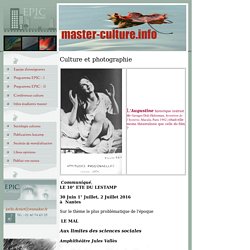
La photographie Une sociologie off ? La photographie : une sociologie off ? C’est avec plaisir que j’ai accepté la proposition faite par Mateusz Targowski de réaliser dans le cadre de ce festival Diaporama, cette conférence autour de sociologie et photographie. Mais là n’est pas le centre de mon propos qui est plus général et qui commencera en préambule par délimiter la nature des questions dont il s’agit de traiter. Préambule D’abord il faut poser que ce lien entre photographie et sociologie n’a rien d’évident. D’ailleurs peu de gens y pensent sans doute ! Questions donc : Visée savante et ambiguïté de la preuve photographique.
John Collier Jr. Early life and family[edit] He was also informally apprenticed to the Western painter, Maynard Dixon, who was then married to the photographer Dorothea Lange.

He spent considerable time in the Dixon / Lange household in San Francisco during his early and mid teens and was trained in a wide range of painting techniques and skills. When in Taos he also received informal training from the artist Nicolai Fechin. This training largely ended in 1930, when he signed on as seaman in the four masted bark Abraham Rydberg for a voyage from San Francisco around Cape Horn to Dublin, Ireland, an experience arranged by Capt. Jean Baudrillard Philosophie Sociologie Photographie - La Di.
Culture fiches bourdieu 1965. Ce que la photographie plasticienne peut pour la sociologie. La transversalité du médium photographique conduit celui qui en fait usage à naviguer d'une discipline à l'autre.
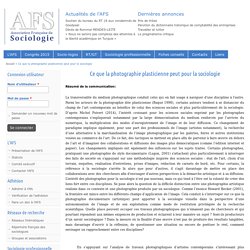
Parmi les acteurs de la photographie dite plasticienne (Baqué 1998), certains auteurs tendent à se distancier du champ de l’art contemporain au bénéfice de celui des sciences sociales et plus particulièrement de la sociologie. PHOTOGRAPHIE, sociologie et esthétique. Accueil - Contact - Mentions légales Consulter les articles d'Encyclopædia Universalis : 0-9 A B C D E F G H I J K L M N O P Q R S T U V W X Y Z Consulter le dictionnaire de l'Encyclopædia Universalis © 2016, Encyclopædia Universalis France.
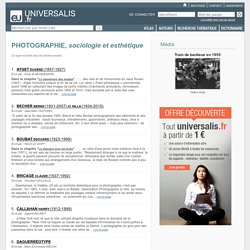
Lewis Hine, la photographie comme la sociologie est un sport de combat - ViteVu. Douglas Harper. Douglas A.

Harper (born 1948) is an American sociologist and photographer.[1] He is the holder of the Rev. Joseph A. Lauritis, C.S.Sp. Endowed Chair in Teaching with Technology at Duquesne University, a chair funded by a grant from the Mellon Foundation.[2] Biography[edit] Harper was born in Saint Paul, Minnesota. Career[edit] After graduation, Harper wrote a book, Good Company,[4] about railroad tramps. Harper. Harper VS. Harper. Témoignage d’une passion pour la photographie et de son apport à la sociologie – Sociologie visuelle. Le dernier ouvrage de Douglas Harper s’intitule Visual Sociology (2012).
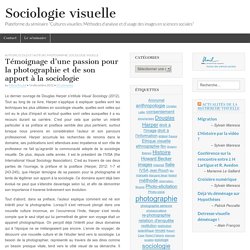
Tout au long de ce livre, Harper s’applique à expliquer quelles sont les techniques les plus utilisées en sociologie visuelle, quelles sont celles qui ont eu le plus d’impact et surtout quelles sont celles auxquelles il a eu recours durant sa carrière. C’est pour cela que porter un intérêt particulier à sa préface et postface semble des plus pertinent, surtout lorsque nous prenons en considération l’auteur et son parcours professionnel. Harper accumule les recherches de renoms dans le domaine, ses publications sont attendues avec impatience et son rôle de professeur ne fait qu’agrandir la communauté adepte de la sociologie visuelle. De plus, depuis cette année, il est le président de l’IVSA (the International Visual Sociology Association). Sociologie visuelle. Un article de Wikipédia, l'encyclopédie libre.
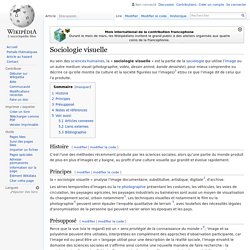
Au sein des sciences humaines, la « sociologie visuelle » est la partie de la sociologie qui utilise l’image ou un autre medium visuel (photographie, vidéo, dessin animé, bande dessinée), pour mieux comprendre ou décrire ce qu’elle montre (la culture et la société figurées sur l’images)[1] et/ou ce que l’image dit de celui qui l’a produite. Histoire[modifier | modifier le code] C’est l’une des méthodes récemment produite par les sciences sociales, alors qu’une partie du monde produit de plus en plus d’images et y baigne, au profit d’une culture visuelle qui grandit et évolue rapidement.
Principes[modifier | modifier le code] Introduction à la sociologie visuelle. Articles du GRIS. Sociologie visuelle, photographie documentaire et photojournalisme. Howard S.
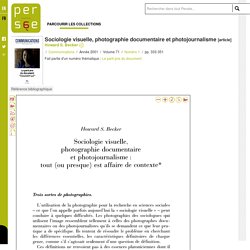
Becker BIBLIOGRAPHIE ATGET, E., 1992, Atget Paris, Paris, Hazan. BATESON, G., et MEAD, M., 1942, Balinese Character, New York, New York Academy of Sciences. BECKER, H.S., 1982, Art Worlds, Berkeley, University of California Press (Les Mondes de l'art, Paris, Flammarion, 1988). - 1986, « Telling about Society », Doing Things Together, Evanston (111.), Northwestern University Press, p. 121-135. Sociologie visuelle [Études experimentales de la réception. Les prolongements théoriques ou méthodologiques] La sociologie visuelle - Département de sociologie - UNIGE. Une sociologie avec les images.

Photographie – Sociologie visuelle. « Moi, je prends la photo et je suis celui qui vous montre cette scène et qui la monte par cette légende.
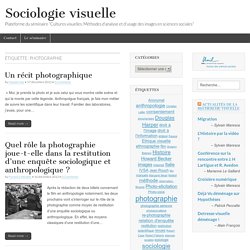
Anthropolgue français, je fais mon métier de suivre les scientifique dans leur travail. Familier des laboratoires, j’avais, pour une… Read more → Après la rédaction de deux billets concernant le film en anthropologie notamment, les deux prochains vont s’interroger sur le rôle de la photographie comme moyen de restitution d’une enquête sociologique ou anthropologique. En effet, les moyens classiques d’une restitution d’une… Read more → On peut se questionner sur le rapport qui existe (ou non) entre ce qu’on appelle une photographie scientifique et une photographie esthétique. Read more → Howard Becker – Sociologie visuelle. Sociological Record. Zofia Rydet: the woman who tried to photograph every house in Poland – in pictures. Zofia Rydet, the old lady who wanted to photograph the inside of every single house in Poland – We Make Money Not Art. Zofia Rydet was 67 years old when she set herself the herculean task of photographing the inside of every single house in Poland.
From 1978 until her death in 1997, she would frantically travel by bus or foot over the country, have people sit in their interior, straight in front of her, and shoot them using a wide-angle lens and flash. As if the self-assigned task of portraying individuals and families at home in Poland wasn’t formidable enough, Rydet also added numerous sub-categories of photos to the series. Some focused on tv sets inside the home, others on kitchen windows seen from the inside, photos and objects celebrating Pope John Paul II, women on doorsteps, disappearing professions, etc. Rydet gave a title to her obsessive catalogue of people and objects, she called it Sociological Record. Zofia Rydet. Record, 1978-1990 - Museum of Modern Art in Warsaw. "Sociological Record" abounds in contradictions – rather than a cycle of research or inventory photography (as the title, originally provided by Urszula Czartoryska suggests), it is a total project that sits within the tradition of intuitive artistic atlases and catalogues.
Hence the title of the exhibition, which omits the “sociological” aspect of the series: record is regarded as a method that escapes the rules of a scholarly inventory. Writer and curator Wojciech Nowicki wrote in his book "Dno oka. Eseje o fotografii" [Bottom of the Eye. Essays on Photography]: “Record develops simultaneously in all directions, it carries on devouring new territories, it has tentacles that reach to all sides at the same time.”
At the same time, "Sociological Record" broke into numerous sub-categories that escaped the principles of the project. Zofia Rydet - Biography. Her photographs are deceptively simple, taking an intimate, direct approach to her subject, trailing main tropes of Pictorialism, painting during the Young Poland period, abstraction and surrealism, and applying them to photography. Zofia Rydet. Frieze Magazine. Zofia Rydet Museum of Modern Art, Warsaw, Poland All images: Zofia Rydet, from the series ‘Sociological Record’, 1978–90. Zofia Rydet: Sociological Record - Photographs from Zofia Rydet's Sociological Record. Zofia Rydet’s Sociological Record represents one of the most important achievements in 20th-century Polish photography. The project, created between 1978–1997, is a sweepingly comprehensive documentary portrait of Polish domestic life. The photos span decades, eras, regions, cultures, and subject material.
Zofia Rydet. Zofia Rydet and Július Koller. Zofia RydetRecord, 1978–1990 Curators: Sebastian Cichocki, Karol Hordziej Zofia Rydet. Record, 1978–1990 offers the presentation of Zofia Rydet’s legendary photographic project Sociological Record. The artist began the development of the cycle in 1978 and continued almost until her death in 1997. Zofia Rydet’s Sociological Record is an exhaustive look at how Polish people live. Zofia Rydet, courtesy of Zofia Rydet Foundation Who hasn’t peeked into an apartment as a neighbor exits, allowing for a quick glimpse inside as the door closes?
Or gone to a local open house to investigate a home you might have passed hundreds of times but never knew what was inside? A friend of mine told me that she and her mother used to walk around their neighborhood in the evening when the darkening sky and illuminated picture windows made it easier to see what was inside. Operating under a much less creepy method, Polish photographer Zofia Rydet spent two decades photographing the interior of Polish homes for a series titled “Sociological Record.”
Zofia Rydet’s "Sociological Record" archive. The Foundation for Visual Arts, in collaboration with the Zofia Rydet Foundation, the Museum in Gliwice, and the Museum of Modern Art in Warsaw, are proud to present the ambitious archival project dedicated to the preservation and dissemination of Zofia Rydet’s magnum opus—the immense photographic series “Sociological Record.” The result of this ongoing research is now available to the public, via the website and an online database. “Sociological Record” (realized between 1978 and 1997), represents one of the most important achievements in 20th-century Polish photography.
Of canonical significance, the work has nevertheless remained something of a challenge for scholars and art critics alike, owing to the sheer breadth of the project’s scope and Rydet’s prolific industriousness. At the time of Zofia Rydet’s death in 1997, the “Sociological Record” had come to encompass some 16,000 negatives, many of which were never to see the light of day during Rydet’s career. GB. ENGLAND. June Street. 1972. < Back to collections by Martin Parr Martin Parr - GB. ENGLAND. Daniel Meadows. Daniel Meadows and the Free Photographic Omnibus, December 1974. Self-portrait photographed using a tripod and timer. Daniel Meadows (born 1952) is an English photographer turned maker of digital stories, and a teacher of photography turned teacher of participatory media. Life and career as photographer[edit]
FR – Daniel MEADOWS & Martin PARR– June Street. Daniel Meadows: documenting the 70s and 80s. Street life. La Mise en scène de la vie quotidienne. La Mise en scène de la vie quotidienne. Lecture de Goffman. Du jeu à la convention. Le self comme interprétation chez Goffman. Erving Goffman et les rites de la vie quotidienne. Chauncey Hare PROTEST PHOTOGRAPHS.
The Exposure Project: Chauncey Hare. 5B4: Protest Photographs by Chauncey Hare. Protest Photographs - FOTO8. Two Slight Returns: Chauncey Hare and Marianne Wex. American Photography and the American Dream - James Guimond. Evan Sklar: Chauncey Hare - "Interior America" Bint photoBooks on INTernet: Interiors of working-class homes and workplaces across America in the late 1960s and early 1970s Chauncey Hare Protest Photographs Photography. Le promeneur du 68: Le photographe Chauncey Hare face aux victimes du travail. Protest Photographs – Lucida Journal. Bill Owens. Bill Owens (photographer) Suburbia by bill owens. Bill Owens. Shooting the American Dream in Suburbia. Bill Owens - 'Suburbia' (2000) Art a GoGo Interview: Bill Owens. Greg Kucera Gallery. Karen Knorr. Belgravia by Karen Knorr. Press Release46. Bieke Depoorter.
Sint-Pietersabdij. Bieke Depoorter - I Am About To Call It a Day. Total Strangers Let This Photographer Crash for a Night in Their Homes. Bieke Depoorter Photographs Home in Faraway Places.